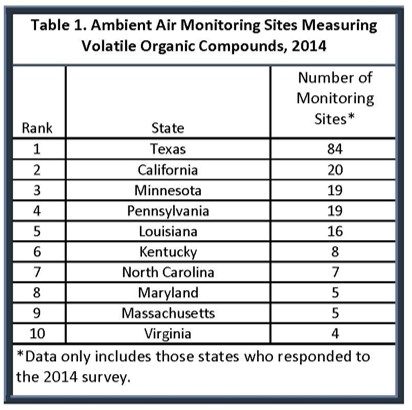Cumulative Risk from Airborne Chemicals
Normally, people are exposed to many chemicals from many sources every day—both human-made and naturally occurring—in food, water, soil, and air. For example:
◦naturally occurring chemicals and food additives
◦emissions from cars, dry cleaners, and industrial sources
◦natural minerals such as arsenic and by-products from disinfection in drinking water
◦chemicals from soil that volatilize (become vapors)
◦emissions from vegetation and wildfires
Exposure to chemicals is associated with some level of risk of adverse effects on health (defined as damage to normal functions of the body, which can include such problems as irritation and lung disease, as well as cancer). The body can generally remove harmful chemicals, but sometimes it may not be able to get rid of a chemical before it can cause harm. As the amount of chemical a person is exposed to increases, so does the likelihood of harm. Exposure of a person to one chemical from multiple sources is called aggregate exposure. Exposure from multiple sources is called cumulative exposure.
Cumulative risk is the combined risk from exposures to multiple chemicals from multiple sources. Cumulative-risk assessment aims to evaluate adverse health effects from all chemicals from all possible sources to determine the overall risk to human health.
In the environment, chemicals can interact with each other, which can increase or decrease their toxicity or have no effect. Therefore, besides identifying chemicals and their individual concentrations, cumulative-risk assessment also attempts to characterize chemical interactions, especially when they may increase toxicity.
Although chemicals are emitted from a variety of sources, the TCEQ only has statutory authority to regulate emissions from stationary facilities, such as power plants and refineries. The federal government has regulatory authority over most mobile sources. The TCEQ currently addresses aggregate and cumulative exposures from air primarily through air permitting and through its extensive monitoring of outdoor air.
The TCEQ’s Toxicology Division calculates safe concentrations of chemicals in air, which are used in the permitting process to establish maximum emission rates. Maximum emission rates are then written into enforceable air permits. The guidelines for developing these levels, called Effects Screening Levels (ESLs), were peer-reviewed outside of the agency by world-renowned experts in inhalation toxicology and risk assessment. The guidelines—and the ESLs calculated from them—are scientifically sound assessments of a chemical’s potential for adverse health effects.
The method for deriving these ESLs (described in detail at TCEQ Guidelines to Develop Toxicity Factors) addresses both cumulative and aggregate exposures. The risk-management goal for cancer-causing chemicals is 1 in 100,000, the theoretical added cancer risk (above the background cancer risk of about 1 in 3) that a chemical may cause over a lifetime of exposure in the most sensitive portions of the population. In other words, lifetime exposure to a permitted chemical carcinogen at the 1-in-100,000 risk level would increase the chances of such persons developing cancer from 33 percent to 33.001 percent in a worst-case estimate of risk. This 1-in-100,000 risk level is 10 times more stringent than the highest level that the EPA deems acceptable.
For all other chemicals, the TCEQ derives a scientifically sound, safe level, then tightens that number by 70 percent for evaluating air-permit applications.
The TCEQ’s extensive air-monitoring network helps verify that its permitting process has been effective for multiple emission sources even in the most industrialized areas of Texas. The TCEQ benefits from the largest stationary monitoring network in the country (Table 1). Many of these monitors are placed in areas with densely packed sources, such as industrial areas, which represent a worst-case scenario of aggregate exposure—giving the agency high confidence that policies and practices that work in those areas will work equally well in less-industrial areas.

Monitors provide reliable data on aggregate and cumulative exposure as they measure the air concentrations due to emissions from all sources (such as industrial sites, mobile sources such as cars, and area sources such as gas stations). The vast majority of the monitors in the state showed annual average concentrations under the 1-in-100,000 screening level for carcinogenic chemicals like benzene. Because actual monitoring data verify acceptable exposure levels and the ESLs are inherently conservative and health protective, the TCEQ is confident that the potential of additional impacts from individual sources in an area are minimal.
The TCEQ also uses cumulative risk assessments from other organizations, such as the EPA’s NATA, to identify areas with computer-modeled concentrations above a level of concern. Although NATA is based on a theoretical model of reported emissions rather than actual monitored concentrations, the assessment helps the TCEQ identify other potential issues.
Finally, in the limited areas (about 0.08 percent of the state) where actual monitored concentrations of chemicals indicate a potential concern, the TCEQ uses the Air Pollutant Watch List to reduce ambient (outdoor air) levels. The list considers all the possible sources of the chemical of concern.
For more detailed information on risk assessment at the TCEQ, please contact the Toxicology Division, by phone—toll-free: 877-992-8370, local: 512-239-3900—or e-mail: tox@tceq.texas.gov
E-mail us at tox@tceq.texas.gov. If you wish to reach a particular staff member, please put “Attn:” and the staffer’s name in the subject line.
Phone Numbers
Toll-Free: 1-877-992-8370
Local: 512/239-1795
Fax: 512/239-1794
Toxicology Division Director
Sabine Lange, Ph.D., DABT
Toxicology Division Section Manager
Darrell McCant, M.P.H., DABT
Toxicologists
Stanley Aniagu, Ph.D., DABT
Angela Curry, M.S.
Janet Hamilton, Ph.D., DABT
Joseph Haney, M.S.
Cassandra Henry, Ph.D.
Allison Jenkins, M.P.H.
Stony Lo, Ph.D.
Nnamdi Nnoli, Ph.D.
Tracie Phillips, Ph.D.
Anthony Tran
Mingyuan Wei
Lisa Westbrook, M.S.
